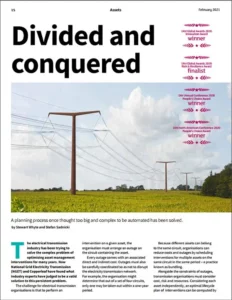Feature Article: Divided and Conquered
“Divided and Conquered”—written by Stewart Whyte, Head of Delivery Optimisation, NGET, and Stefan Sadnicki, Managing Director, Copperleaf EMEA, reproduced with permission from The Institute of Asset Management. This feature article was originally published in the February 2021 issue of Assets, a quarterly digital magazine distributed to all full members of the IAM.

The electrical transmission industry has been trying to solve the complex problem of optimising asset management interventions for many years. Now National Grid Electricity Transmission (NGET) and Copperleaf have found what industry experts have judged to be a valid solution to this persistent problem.
The challenge for electrical transmission organisations is that to perform an intervention on a given asset, the organisation must arrange an outage on the circuit containing the asset.
Every outage comes with an associated direct and indirect cost. Outages must also be carefully coordinated so as not to disrupt the electricity transmission network. For example, the organisation might determine that out of a set of four circuits, only one may be taken out within a one-year period.
Because different assets can belong to the same circuit, organisations can reduce costs and outages by scheduling interventions for multiple assets on the same circuit in the same period—a practice known as bundling.
Alongside the constraints of outages, transmission organisations must consider cost, risk and resources. Considering each asset independently, an optimal lifecycle plan of interventions can be computed by considering the cost of performing each possible intervention in each year and the monetised risk reduction the intervention achieves. Each intervention also requires resources, such as personnel and spare parts, so they must be scheduled at a time when the necessary resources are available.
So the technical challenge is to find the optimal intervention schedule for each asset in the transmission network, while considering the benefits of bundling gains, the outage and resource constraints, and any relevant business rules.
This optimisation has historically been a manual process, relying on a planner recognising potential work bundling opportunities, then building all the resource and outage requirements together into a deliverable package.
This is the most complex optimisation problem Copperleaf has ever solved.
Stan Coleman
CTO
Copperleaf
There was no existing industry practice for solving this problem in an organisation like National Grid. The complexity of the optimisation problem grows exponentially with the number of assets, and NGET manages in excess of 60,000 assets, including circuit breakers, instrument transformers, supergrid transformers, and more. Existing solutions also could not support the non-linear calculations involved in accounting for outage durations.
But with asset management interventions forming part of an investment plan worth between £800 million and £1 billion a year at NGET, the value of effective optimisation is very high.
The scale of NGET’s asset base made an algorithm a more attractive option than a manual process. But it was uncertain, starting out, whether it would be possible to create an algorithm capable of computing the optimal intervention schedule.
NGET and Copperleaf worked together to combine the power of Copperleaf’s Decision Analytics platform, its consulting and software development expertise, and the engineering knowledge and prototypes that have been nurtured within NGET over the years. The innovation solution enables NGET to run network-wide optimisations involving more than 60,000 assets. These optimisations consider more than 5,000 interventions per year; 50 teams, each with up to five different resource types; and 100 overlapping boundaries for circuit constraint management.
The challenge with complex analytical solutions such as this is to truly embed the new capability into business processes. Far too often, a valuable solution is “owned” by a small number of siloed individuals: the only ones able to understand the data input process, the algorithms, and how to interpret the results.
What makes this project stand out is how NGET has embedded the new optimisation capability as a central part of its standard asset investment planning process. NGET made a conscious decision to implement the finished solution using a commercial off-the-shelf software package. The Copperleaf system integrates asset, maintenance and investment data from existing enterprise systems, automating the data input process. A suite of eight programmatic integrations run either:
- nightly (to import updated asset data, for example)
- monthly (to bring in existing investments that are fixed in the schedule, such as a commitment to connect a customer)
- ad hoc (to update FMEA risk model inputs, for example)
The new capability went live in September 2019 and is already delivering significant benefits.
Monetised risk, asset intervention planning, and circuit optimisation can now be handled together in one simple, centralised platform. Instead of having to work with five different tools or spreadsheets, NGET people can now find everything they need in a single screen in the Copperleaf solution. This has also helped to reveal long-term resource requirements and pinch points across the network, where NGET needs to recruit and build resource capacity.
Enhanced asset lifecycle modelling has led to improved risk management, as well as ensuring that NGET selects the right interventions, at the right time, at the right cost for consumers.
The circuit optimisation solution is underpinned by a cutting-edge and complex algorithm that was co-developed with Copperleaf. This is helping National Grid Electricity Transmission further improve our ability to anticipate and manage asset risks, ensuring we continue to make the right investment decisions across our network.
David Wright
Group Chief Engineer
National Grid
The capability has improved planning efficiency by 50 per cent, reducing the time needed to build the plan for the 2022 fiscal year from the usual 12 weeks to just six weeks. The ability to carry out what-if analyses more quickly has been particularly important, because NGET has had to deconstruct and rebuild the plan under a range of different scenarios through the course of the COVID-19 pandemic.
Outage requirements are down across the network. For example, the number of circuits requiring an outage three times in a five-year period is down from 18 per cent to just eight per cent of circuits. The bundling ratio (the number of interventions per outage) for the 2022 fiscal year plan has increased by 66 per cent compared to the old manual bundling process. This has avoided at least 1,000 outages and potentially £6 million in corresponding outage setup costs. The proposed interventions and benefits are based on the constraints, such as risk appetite, and the outputs that need to be delivered.
A patent application for the multi-step technique is in progress. This ground-breaking project won the Innovation Award at the 2020 IAM Global Awards and was also awarded the 2020 People’s Choice Award—voted for by all attendees at the IAM Annual Conference and the IAM North American Conference.
Learn more about our innovative work with National Grid here.

